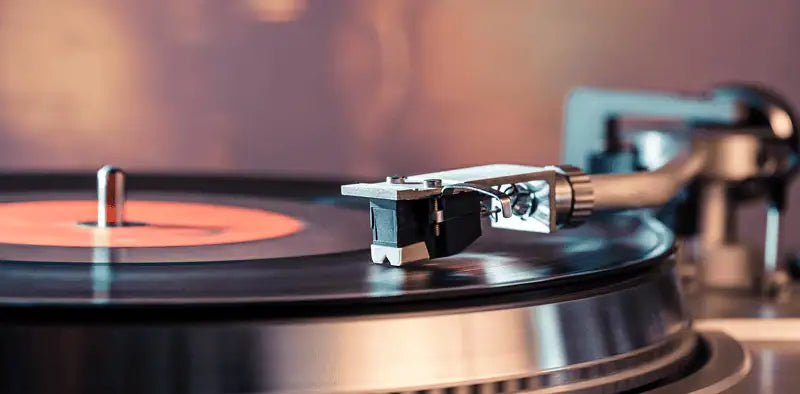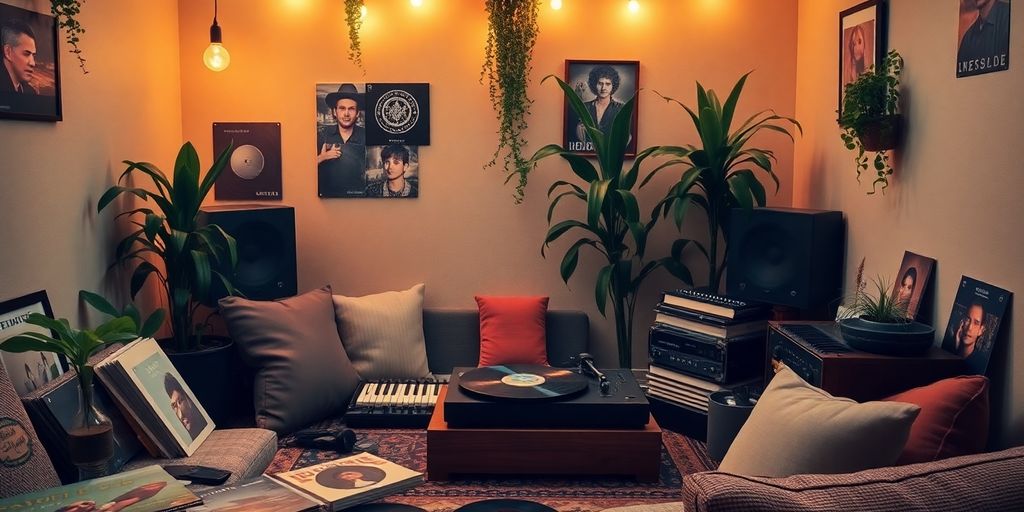In our perpetually connected, often overwhelming modern world, the search for moments of calm and digital detox has become increasingly vital. Amidst the myriad wellness trends, the simple act of listening to vinyl records emerges as a potent, tangible antidote for many. It's more than just background music; engaging with vinyl can be a deliberate ritual that promotes relaxation. But how do you curate the ultimate "chill" vinyl playlist? This guide explores not just the types of music conducive to calm but also analyzes why the vinyl format itself lends itself to relaxation, blending practical curation principles with an understanding of the format's unique characteristics and our psychological responses to them. Building this playlist is about selecting sounds and embracing a process.

The Ritual of Relaxation: Why Vinyl Lends Itself to Calm
The perceived relaxing quality of vinyl isn't solely about the music; the physical act of playing a record contributes significantly to the experience, fostering a sense of calm through mindful engagement.
The process demands Mindful Engagement. Selecting a record from your collection, carefully removing it from the sleeve, perhaps giving it a quick clean, placing it on the turntable, and gently lowering the stylus – each step requires presence and focus. This deliberate sequence draws attention away from scattered digital notifications and encourages being fully present in the moment, aligning with core mindfulness principles.
Interacting with the physical record and turntable provides Tactile Grounding. The weight of the record, the texture of the cover, the mechanical motion of the player – these sensory inputs anchor us in the physical world, offering a counterpoint to the often disembodied experience of navigating digital interfaces (First Principle: Sensory Input & Grounding).
Vinyl playback necessitates Intentionality and Slowing Down. Unlike instantly accessible streaming playlists, playing a record requires dedicating time and physical space. You typically listen to a side at a time (around 20 minutes), encouraging a slower pace and a more committed listening session, rather than constant skipping or background multitasking.
Furthermore, the much-discussed "Warmth" Factor might play a role. As analyzed previously, the specific sonic signature of vinyl – potentially including pleasing harmonic distortion and a gentler high-frequency roll-off – may be subjectively perceived by some listeners as more soothing, less fatiguing, or more "organic" than the potentially hyper-detailed, sharp presentation of some digital audio, contributing to a relaxed feeling.
Curating Calm: Principles for Building Your Chill Vinyl Playlist
Creating a playlist for relaxation goes beyond simply grabbing albums labeled "chillout." It requires considering the underlying principles of what makes music calming and how vinyl interacts with those principles.
Move Beyond Genre Tropes. Relaxation is deeply subjective. Instead of relying solely on genre labels like "ambient," analyze the specific musical characteristics that tend to induce calm: often slower tempos, consonant (or gently dissonant) harmonies, predictable or slowly evolving structures, an absence of sudden loud dynamic shifts, and a sense of spaciousness in the mix.
Consider Timbre and Texture. Certain instrumental sounds are often associated with relaxation – the warmth of acoustic guitars, the gentle chime of a Rhodes piano, the sustained tones of string instruments or soft synthesizers. Analog recording and vinyl playback can sometimes impart subtle textures (like tape saturation, if present in the recording) that add to this feeling. How vinyl renders these textures compared to digital can be part of its unique appeal for relaxation.
Think about Flow and Sequencing. An album designed with a cohesive flow or the deliberate sequencing of tracks on Side A and Side B can create an uninterrupted journey conducive to unwinding. The physical act of getting up to flip the record can serve as a natural, mindful pause rather than an interruption, breaking up the session gently.
Balance Familiarity and Discovery. A truly effective relaxation playlist might include both beloved, comforting albums that evoke a sense of safety and predictability, alongside gentle, exploratory new sounds that engage the mind softly without demanding too much attention.

Genre Exploration for Relaxation (Examples & Analysis)
While personal taste is paramount, certain genres are frequently cited for their relaxing qualities. Here’s an exploration, focusing on why they might work on vinyl:
Ambient and Environmental Music is perhaps the most obvious category. Artists like Brian Eno (a pioneer of the genre), Stars of the Lid, or select works by Aphex Twin utilize texture, space, and non-linear structures to create immersive soundscapes. These pieces often lack strong melodies or driving rhythms, instead inviting the listener into a sonic environment ideal for contemplation, focus, or simply being. Vinyl can enhance the textural details and perceived "organic" nature of these recordings. Find more via resources like the Ambient Music Guide.
Minimalist Classical and Modern Composition offers another avenue. Composers such as Philip Glass, Max Richter, or Nils Frahm often employ repetitive patterns, slow harmonic shifts, and a focus on sonic texture over complex development. This structural approach can induce a meditative or trance-like state, calming the mind through gentle repetition. The dynamic range and surface noise of vinyl might interact interestingly with these often quiet and subtle compositions.
Certain Jazz Subgenres lend themselves well to relaxation. Think of the understated elegance of Cool Jazz (Miles Davis' Kind of Blue is a classic example), the introspective piano trio work of Bill Evans, or the spacious, atmospheric recordings often found on the ECM Records label. The emphasis on mood, subtle interplay, specific instrumentation (like muted trumpet or vibraphone), and space within the arrangements creates a sophisticated yet calming atmosphere.
Folk and Acoustic Music, particularly works by artists like Nick Drake or the mellower side of Joni Mitchell, often provides comfort. The appeal lies in the natural timbres of acoustic instruments, the directness of the human voice (if lyrics are gentle), and often simpler, more transparent arrangements that feel intimate and grounding.
Even Lo-Fi Hip Hop / Chillhop, though digitally native, sees vinyl releases. This genre explicitly cultivates a relaxed, often nostalgic vibe using mellow beats, jazz samples, and textures intentionally designed to sound "worn" or "analog," sometimes even adding artificial vinyl crackle. Experiencing this on actual vinyl adds a layer of meta-commentary while fulfilling the intended relaxing mood.
Dub and Gentle Reggae utilize rhythm, space (through heavy use of echo and reverb), and prominent bass frequencies to create a hypnotic, physically relaxing, and laid-back feel. The focus is often on groove and atmosphere rather than complex melody or harmony.
Remember, these are starting points. The ultimate chill playlist is deeply personal. What matters is finding sounds that resonate with your sense of calm.
Optimizing the Environment: Beyond the Playlist
Creating a relaxing experience involves more than just the music. Consider the listening environment.
Ensure a Comfortable Listening Space. This might involve comfortable seating, reducing visual clutter, and perhaps dimming the lights to minimize external stimuli.
Pay attention to Playback Quality. While audiophile perfection isn't necessary for relaxation, a turntable setup that is free from obvious distortions, excessive noise (beyond gentle surface noise), or speed inconsistencies will contribute to a less stressful session. Ensure your turntable, especially if budget-friendly, is properly set up and not actively damaging your records.
Minimize Distractions. Turn off phone notifications, close unnecessary tabs, and consciously dedicate the time solely to listening and unwinding.
Potential Pitfalls & Reality Check
While vinyl can be a wonderful tool for relaxation, it's important to acknowledge potential downsides.
The Cost Factor remains. Building a dedicated collection of relaxing records, especially if seeking specific pressings or genres, can become expensive, potentially introducing financial stress—the opposite of the intended effect.
Surface Noise Intrusion can be a deal-breaker for some. While many find gentle crackle atmospheric, others find any clicks, pops, or hiss distracting and counterproductive to relaxation. This perception is highly subjective.
Consider the line between Escapism vs. Mindfulness. Is using music solely to "zone out" a healthy coping mechanism or a form of avoiding present realities? Using vinyl mindfully, focusing on the sensory experience, can be a valid tool, but awareness of intent is useful.

Beware the Commodification of Wellness. The market may sometimes frame any slow or atmospheric music on vinyl as a "wellness product." Approach such marketing critically and choose music based on genuine personal resonance, not just labels.
Conclusion: Enjoying the Analog Path to Calm
Combining the inherent qualities of the vinyl format with carefully selected music creates a powerful pathway to relaxation and mindfulness in our often chaotic world. The deliberate ritual of playing a record encourages presence, the physical object offers a grounding anchor, and the specific sonic characteristics can contribute to a soothing atmosphere. Building your ultimate chill playlist is a personal journey of discovery, exploring not just genres and artists, but also your own response to sound and the unique experience that vinyl provides. It's an invitation to slow down, listen intentionally, and reconnect with music on a tangible level. Embracing this process can be a rewarding way to cultivate calm and create personal sanctuaries in everyday life (for more on intentional living and creating mindful spaces, consider exploring XJ-HOME).





Leave a comment
All comments are moderated before being published.
This site is protected by hCaptcha and the hCaptcha Privacy Policy and Terms of Service apply.